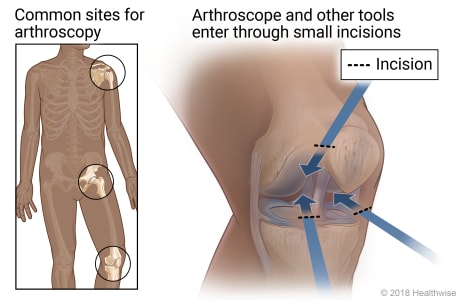Arthroscopy for Rheumatoid Arthritis
Surgery Overview
Arthroscopy is a type of joint surgery in which a thin tube with a light source (called an arthroscope) is inserted into the joint through a small incision (cut) in the skin. This allows the doctor to see the inside of the joint. Special tools are inserted through other small cuts to work on the joint or the soft tissues around it. Surgery will not cure rheumatoid arthritis or stop the disease's progress. But it may improve function and provide some pain relief.
How It Is Done

Arthroscopic surgery (arthroscopy) is a surgical procedure that allows your doctor to look at the inside of a joint in your body through a thin viewing instrument called an arthroscope. Common sites for the procedure include the shoulder, hip, and knee.
During arthroscopy, the arthroscope is inserted into your joint through a small cut (incision) in the skin. The arthroscope has a light source and a video camera attached to it. Images from the camera can be seen on a video monitor. These magnified images provide a clear picture of your joint. A sample of joint tissue can be collected during arthroscopy for biopsy. If surgery is done, additional instruments will be inserted into your joint through other small incisions.
What To Expect
Arthroscopy usually does not require an overnight stay in the hospital. Your recovery will depend on the type and extent of your procedure. You may just need to rest the joint and then slowly return to activity. But sometimes crutches or a brace is needed. And in some cases your doctor will recommend rehab.
Why It Is Done
This procedure is used to treat joints without making a large cut. Procedures done with arthroscopy include:
- Repairing soft tissues such as tendons.
- Removing any free-floating pieces of bone or cartilage from the joint.
- Smoothing out rough or irregular joint surfaces.
- Limited removal of inflamed tissues (synovectomy) in larger joints.
This procedure may not be the right choice if joint destruction is severe.
How Well It Works
Arthroscopy temporarily relieves pain and sometimes eases joint movement. But it does little to slow the progression of the disease.
Current as of: July 24, 2025
Author: Ignite Healthwise, LLC Staff
Clinical Review Board
All Ignite Healthwise, LLC education is reviewed by a team that includes physicians, nurses, advanced practitioners, registered dieticians, and other healthcare professionals.